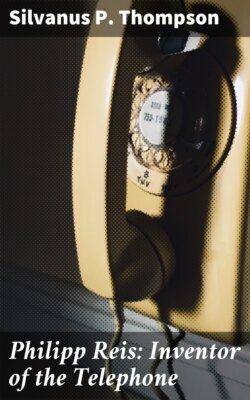Читать книгу Philipp Reis: Inventor of the Telephone - Silvanus P. Thompson - Страница 19
На сайте Литреса книга снята с продажи.
Third Form.—The Electro-magnet Receiver.
ОглавлениеThough the precise history of this form of telephonic receiver is defective, there can be little doubt that it was conceived by Reis amongst his earliest researches. When there were in common use so many electric and telegraphic instruments in which an electro-magnet is employed to move an armature to and fro, it is not surprising that Reis should have thought of availing himself of this method for reproducing the vibrations of speech. Speaking of the two parts of his invention, the Transmitter and the Receiver, Reis himself says:[5] “The apparatus named the ‘Telephone,’ constructed by me, affords the possibility of evoking sound-vibrations in every manner that may be desired. Electro-magnetism affords the possibility of calling into life at any given distance vibrations similar to the vibrations that have been produced, and in this way to give out again in one place the tones that have been produced in another place.” A remark, almost identical with this, is also made by Inspector von Legat (see p. 74) in his Report on Reis’s Telephone. It may be here remarked that the form of this receiver is known only from the figure and description given in that Report, and from the extract therefrom printed in Kuhn’s ‘Handbook’ (see p. 109). Reis seems to have very soon abandoned this form, and to have returned to the needle, surrounded by a coil, in preference to the electro-magnet. The electro-magnet form is, however, of great importance, because its principle is a complete and perfect anticipation of that of the later receivers of Yeates, of Gray, and of Bell, who each, like Reis, employed as receiver an electro-magnet the function of which was to draw an elastically mounted armature backwards and forwards, and so to throw it into vibrations corresponding to those imparted to the transmitting apparatus. Fig. 21 shows the disposition of the electro-magnet, and of its vibratory armature upon a sounding-board. This apparatus was a good deal larger than most of Reis’s instruments. The sounding-board was nearly a foot long: the coils of the electro-magnet were six inches long, and over an inch thick. The armature, a rod of iron of elliptical section, was affixed cross-wise at the end of a “light and broad” vertical lever, about seven inches long, which seems to have been made of wood, as in Legat’s Report it is also denominated as a “plank” (Balken).
Fig. 21.
